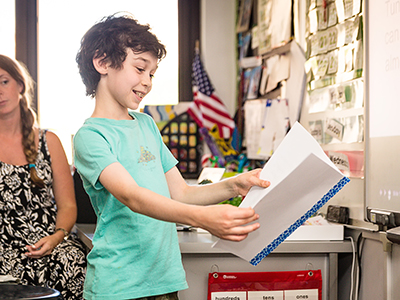By Lindsey Schostak, Coordinator of Social Studies and Writing Departments
 Writing is first and foremost, a method of communication. Since the ancient Sumerians revolutionized language through the invention of cuneiform, humankind has used the written word to communicate with others. Today, people of all ages write constantly. Whether it is through essays assigned by teachers, personal emails, to-do lists, or text messages, we all access the written word throughout the day. Yet this seemingly simple process is comprised of many challenging layers. Therefore, it is imperative that students with learning differences receive structured and systematic writing instruction during their academic career.
Writing is first and foremost, a method of communication. Since the ancient Sumerians revolutionized language through the invention of cuneiform, humankind has used the written word to communicate with others. Today, people of all ages write constantly. Whether it is through essays assigned by teachers, personal emails, to-do lists, or text messages, we all access the written word throughout the day. Yet this seemingly simple process is comprised of many challenging layers. Therefore, it is imperative that students with learning differences receive structured and systematic writing instruction during their academic career.
With this in mind, Stephen Gaynor School created the Gaynor Writing Program. At its core, the Gaynor Writing Program is an expository, or non-fiction, writing program based off of Teaching Basic Writing Skills by Dr. Judith Hochman. It includes systematic instruction from the sentence level to the multi-paragraph level, with an emphasis on how oral language connects to writing. For example, students in the Lower School first learn that a complete sentence is comprised of a “Who” and a “did What,” a subject and a verb. They practice this by speaking simple sentences about their experiences, before matching images, and ultimately writing down their sentences. Imbedded in these sentence structure lessons are grammar rules, from parts of speech through written mechanics. Specific colors and symbols are used to create a more multi-sensory approach to grammar instruction, helping to build each student’s understanding of the rules of the English language.
As students advance through the Gaynor Writing Program, they begin to write single and multiple paragraphs, while simultaneously solidifying sentence skills. Ms. Maylath, Middle School Head Teacher, explains, “Sentence level skills, such as expansion of detail, are taught explicitly and practiced during lessons and on independent assignments. Students can then draw from this practice to incorporate sentence expansion into their writing of paragraphs.”
Notably, authentic writing emerges when lessons connect to content in other subject areas. For example, students in the Green Cluster write research reports based on an aspect of life during ancient Mesopotamia, the civilization they are studying in social studies. Similarly, students in the Orange Cluster write creative legends based on their Native American studies in literacy. Ms. Watson, Lower School Head Teacher explains, “The stronger a student’s understanding of the content, the stronger the actual writing and output.” It is this crosscurricular approach that really brings the Gaynor Writing Program to life.
Writing is an individual process. Teachers analyze student work and writing assessments to tailor the Gaynor Writing Program to meet the individual student’s needs. Our ultimate goal is to teach the foundational skills necessary to become great writers and lifelong communicators.
This article originally appeared in the Summer 2016 issue of the Gaynor Gazette.
